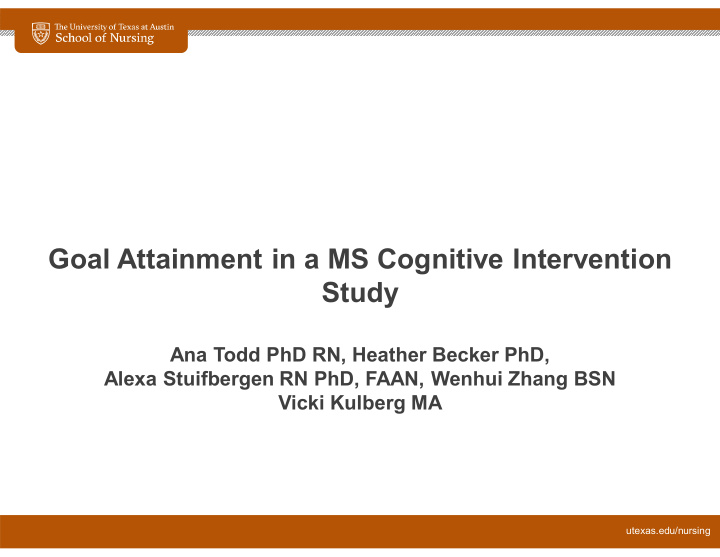



Goal Attainment in a MS Cognitive Intervention Study Ana Todd PhD RN, Heather Becker PhD, Alexa Stuifbergen RN PhD, FAAN, Wenhui Zhang BSN Vicki Kulberg MA utexas.edu/nursing
ACKNOWLEDGEMENT National Institute of Nursing Research R014362- 04 Alexa Stuifbergen and Heather Becker Co-Principal Investigators utexas.edu/nursing
FINANCIAL DISCLOSURE There are no financial relationships to disclose utexas.edu/nursing
LEARNING OBJECTIVES At end of this presentation the learner will be able to: 1) Describe the use of goal attainment in a community-based cognitive intervention for persons with self-reported MS. utexas.edu/nursing
BACKGROUND 60% of persons with multiple sclerosis (MS) report cognitive limitations Goal attainment has been effectively used to evaluate behavior change in in-patient cognitive rehabilitation Little is known about about goal attainment in community-based cognitive intervention studies for persons with self-reported cognitive limitations utexas.edu/nursing
PURPOSE To determine goal attainment and maintenance following participation in a cognitive health promotion intervention for people with MS living independently in the community. utexas.edu/nursing
METHODS Recruitment: Individuals with MS, ages 18-60 years, who reported cognitive limitations from three cities in Texas recruited to participate in a randomized clinical trial of a cognitive intervention. utexas.edu/nursing
METHODS Intervention: 8-week holistic class sessions designed to improve cognitive functioning Facilitators instructed participants to set attainable goals that could improve cognitive functioning at the end of the intervention utexas.edu/nursing
METHODS Data collected about goal attainment were collected at 3 months and 6 months following the end of the intervention. Goal Attainment Scale (GAS) Five-point (-2 to +2) GAS constructed for participants personal goals (Kiresuk, Smith, & Cardillo (1994) utexas.edu/nursing
RESULTS SAMPLE: Average age:49.74 ( SD = 7.41) 74 participants 17.6% Male 82.4%Female: 82% White, Non-Hispanic 74% college or graduate school 66% Relapsing-Remitting MS 5.1 average EDSS score Average length of MS diagnosis: 14.59 yrs. ( SD = 8.33) utexas.edu/nursing
RESULTS Types of Goals Planning/Organizing (n=29) Physical Activity (n=26) Relaxation/Leisure (n=15) Nutrition (n=4) utexas.edu/nursing
RESULTS Sample GAS +2 -2 -1 0 +1 Does not Exercise Exercise Exercise Exercise exercise 1-2 3-4 5-6 Daily times/week times/week times/week utexas.edu/nursing
RESULTS Number of participants who met or exceeded their goal (n=61) 60 50 39 40 36 28 30 20 10 0 3 month follow up 6 month follow up both 3 and 6 month follow up (maintained behavior change) utexas.edu/nursing
RESULTS Overall Changes in GAS scores for 3 and 6 month follow-up (n=61) 60 50 40 27 30 23 20 11 10 0 Increased Stayed the same Decreased utexas.edu/nursing
Sample Barriers to Goal Attainment Health issues Weather Time and energy Caretaking responsibilities Death in family Distractions (work related) Changed or forgot goal utexas.edu/nursing
Strengths/Limitations GAS effective in capturing incremental behavior changes In holistic health promotion interventions Trained facilitators Provides complementary information for standardized tests and self-report measures. Lack of ongoing supportive contact after intervention may influence maintaining behavior change over time Different facilitators may have varying approaches Goal attainment influenced by environmental changes utexas.edu/nursing
Conclusion GAS can be an effective way for facilitators of behavioral programs in community-based settings to assess the attainment of behavioral changes following cognitive health promotion interventions. utexas.edu/nursing
References Asano, M., Preissner, K., Duffy, R., Meixell, M., & Finlayson, M. (2015). Goals set after completing a teleconference- delivered program for managing mulitple sclerosis fatigue. American Journal of Occupational Therapy, 69, 1-6 doi:org/10.5014/ajot.2015.015370 Becker, H. Stuifbergen, A., Taxis, C., Beal, C., Pierini, D. (2009). The use of goal attainment scaling to facilitate and assess individualized change in a wellness intervention for women with fibromyalgia syndrome. Journal of Holistic Nursing, 27 (4), 232-240, doi: 10.1177/08980109339525 Barlow, J., Edwards, R., & Turner, A. (2009). The experience of attending a lay-led, chronic disease self-management programme from the perspective of participants with multiple sclerosis. Psychology and Health, 24, 1167-1180, Doi: 10.1080/08870440802040277 Hanssen, K.T., Benth,J.S., Beiske, A.G., Landro, N.I. & Hessen, E. (2015). Goal attainment in cognitive rehabilitation in MS patients, Neuropsychological Rehabilitation, 25 (1),137-154, Doi: 10.1080/09602011.2014.971818 Kahn, F. Pallant, J., & Turner-Stokes, L. (2008). Use of goal attainment scaling in inpatient rehabilitation for persons with multiple sclerosis. Archives of Physical Medicine and Rehabilitation, 89 , 652-659. Kiresuk, T., Smith, A., & Cardillo, J. (1994). Goal attainment scaling. Hillsdale, NJ: Erlbaum Associates. Plant, S.E., Tyson, S.F., Kirk, S., & Parsons, J. (2016). What are the barriers and facilitators to goal-setting during rehabilitation for stroke and other acquired brain-injuries? A systematic review and meta-synthesis. Clinical Rehabilitation, 30 (9), 921-930, doi: 10.1177/0169215516655856 Stuifbergen, A..K., Becker, H., Timmerman, G., & Kullberg, V. (2003). The use of goal-setting to facilitate behavior change in women with multiple sclerosis. Journal of Neuroscience Nursing, 35 (2), 94-106. utexas.edu/nursing
Recommend
More recommend